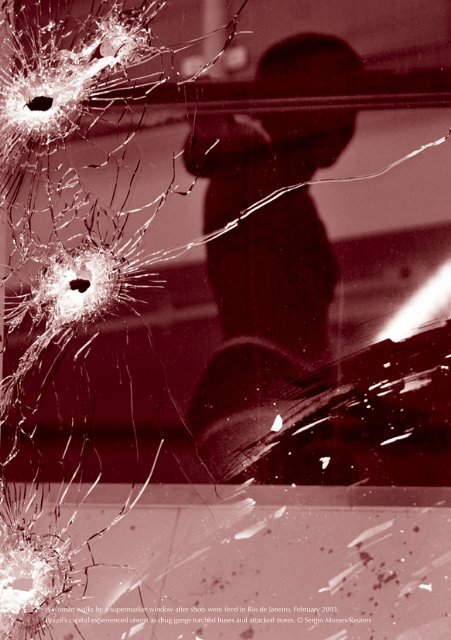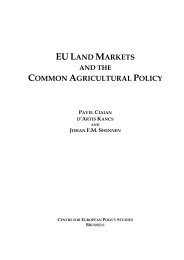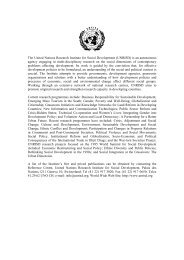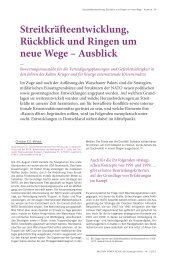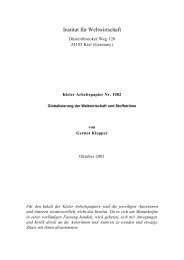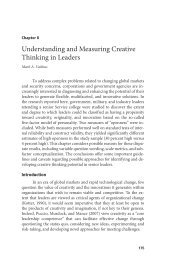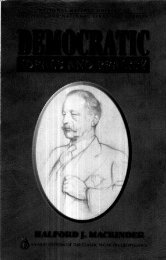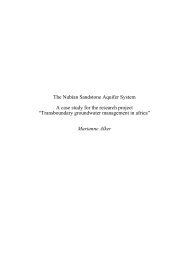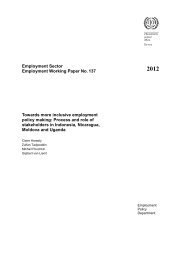Crime and Ammunition Procurement
Crime and Ammunition Procurement
Crime and Ammunition Procurement
Create successful ePaper yourself
Turn your PDF publications into a flip-book with our unique Google optimized e-Paper software.
172 A woman Targeting walks by <strong>Ammunition</strong> a supermarket window after shots were fi red in Rio de Janeiro, February 2003.<br />
Brazil’s capital experienced unrest as drug gangs torched buses <strong>and</strong> attacked stores. © Sergio Moraes/Reuters
6<strong>Crime</strong> <strong>and</strong> <strong>Ammunition</strong> <strong>Procurement</strong>:<br />
The Case of Brazil Pablo Dreyfus<br />
Introduction: weak states, organized crime, <strong>and</strong><br />
patterns of ammunition procurement<br />
Unlike common criminality such as burglary, armed robbery <strong>and</strong> kidnapping<br />
for ransom, organized crime is associated with the production <strong>and</strong> distribution<br />
of illegal goods <strong>and</strong> services such as drugs, illegal gambling, <strong>and</strong> prostitution<br />
as well as extortion linked to the control of services such as gas, electricity, <strong>and</strong><br />
water 1 . In order to achieve their aims, criminal groups use violent means <strong>and</strong><br />
resort to the corruption of offi cials. Criminal organizations not only penetrate<br />
the institutional structures of the state, but also challenge the state by exerting<br />
territorial control by the use of armed force. The extent of this territorial control,<br />
as well as the degree of penetration <strong>and</strong> corruption of state institutions by<br />
criminal organizations, however, depends on the strength of the state in terms<br />
of its level of socio-political cohesion, territorial centrality, 2 socio-economic<br />
development, <strong>and</strong> policy capacity. 3 A country where there is widespread corruption,<br />
a lack of institutional legitimacy, a high degree of inequality, a fragmented<br />
society, <strong>and</strong> ineffi cient or ineffective security forces is less capable of containing,<br />
repressing, <strong>and</strong> controlling criminal organizations (Dreyfus, 2002).<br />
On a ‘weak state–strong state continuum’, 4 countries that are closer to the<br />
‘weak’ pole are more susceptible to criminal organizations with the capacity<br />
to challenge the state’s monopoly on the legitimate use of force, <strong>and</strong> which<br />
acquire fi rearms in order to maintain territorial <strong>and</strong> market control. Lucrative<br />
markets, however, generate competition <strong>and</strong> in the illegal side of the economy<br />
such competition is often characterized by violence (Dreyfus, 2002). In the<br />
Chapter 6 Dreyfus 173
absence of strong institutions capable of enforcing the rule of law there is no<br />
‘peacekeeper’ or even ‘peace enforcer’ <strong>and</strong> this vacuum can lead to an escalation<br />
of armed violence between rival organizations. In such a setting the procurement<br />
of ammunition becomes vital to sustain this escalation. 5 This is the case,<br />
for example, in certain areas of Brazil, Colombia, Nigeria, <strong>and</strong> the Philippines<br />
where organized armed groups involved in illicit activities control territory <strong>and</strong><br />
engage in armed confrontation not only with the state security forces but also<br />
with rival organizations (Dowdney, 2005).<br />
In weak states criminal organizations take advantage of legal loopholes <strong>and</strong><br />
institutional fl aws in order to procure ammunition through the internal <strong>and</strong><br />
external fl ows or procurement routes listed in Table 1. 6<br />
While similar methods are used by organized crime in stronger states such as<br />
Italy <strong>and</strong> the United States, for instance, in weak states widespread corruption,<br />
lack of control by the central state, <strong>and</strong> weak law enforcement structures increase<br />
the magnitude of the problem. In this situation, criminal organizations purchase<br />
arms <strong>and</strong> ammunition with the logic of irregular armies, that is, purchasing<br />
large job lots through illicit channels in order to be able to defend their (rural<br />
or urban) territorial base <strong>and</strong> their markets (Naylor, 2002).<br />
Brazil is treated in this chapter as a paradigmatic case of a weak state facing<br />
the problem of heavily armed criminal organizations that control urban territories<br />
<strong>and</strong> have the capacity to match <strong>and</strong> challenge the state’s security agencies.<br />
Table 1<br />
Internal <strong>and</strong> external ammunition procurement fl ows<br />
Internal fl ows External fl ows<br />
• Diversion (via theft or corruption) from<br />
military <strong>and</strong> police inventories 7<br />
• Diversion from private security companies<br />
<strong>and</strong> gun shops<br />
• Purchase in gun shops by taking advantage<br />
of weak or non-existent controls (particularly<br />
for small calibre ammunition)<br />
• Illicit sales from ammunition factories<br />
<strong>and</strong> shops<br />
• <strong>Ammunition</strong> stolen from individuals in<br />
burglaries (particularly for small calibre<br />
ammunition)<br />
174 Targeting <strong>Ammunition</strong><br />
• International traffi cking networks<br />
• Smuggling of ammunition purchased<br />
in neighbouring countries due to legal<br />
loopholes as well as weak law enforcement<br />
<strong>and</strong> border controls
After the United States, Brazil is the second largest producer of small arms<br />
<strong>and</strong> light weapons <strong>and</strong> related ammunition in the western hemisphere. It also<br />
has one of the highest small arms-related death rates in the world (Dreyfus,<br />
Lessing, <strong>and</strong> Purcena, 2005; Phebo, 2005). This chapter shows how Brazilianmade<br />
ammunition feeds the cycle of criminal violence in some of the country’s<br />
major cities <strong>and</strong> is used by criminal <strong>and</strong> armed non-state groups in the region.<br />
It also analyses the effectiveness <strong>and</strong> possible outcomes of recently enacted<br />
Brazilian fi rearms legislation that inter alia established ammunition marking<br />
measures, which have been in force since July 2005.<br />
Most of the examples used in this chapter are from Rio de Janeiro. <strong>Crime</strong> in<br />
Rio de Janeiro is signifi cant because its particular feature is a strong territorialization.<br />
Drug traffi cking factions compete for armed control over enormous<br />
favelas (poor informal settlements) <strong>and</strong> this provokes violent competition for<br />
control of strategic points for the sale of, in particular, cocaine <strong>and</strong> marijuana.<br />
Assessing the problem<br />
According to national data for 2002, 8 38,088 people were killed using fi rearms<br />
in Brazil in that year <strong>and</strong> 90 per cent of these deaths were homicides. Of the<br />
country’s homicides, 63.9 per cent were committed using fi rearms. In the same<br />
year fi rearm death rates were 21.8 per 100,000 inhabitants, <strong>and</strong> the average<br />
fi rearm-related homicide rate in Brazil’s state capitals was 29.6 per 100,000<br />
inhabitants (Phebo, 2005, pp. 15–21).<br />
This small arms-related violence is linked to weapons misuse <strong>and</strong> to crime<br />
stimulated by drug traffi cking, <strong>and</strong> rooted in social inequality in densely populated<br />
urban areas (Fern<strong>and</strong>es, 1998; Cano <strong>and</strong> Santos, 2001). The central-west<br />
region of the country, where the agricultural frontier is still being extended<br />
through l<strong>and</strong> purchases <strong>and</strong> deforestation, is close to the borders of drugproducing<br />
countries <strong>and</strong> fi rearm mortality has increased by 57 per cent in the<br />
past 20 years. In the south-east part of the country, which contains large urban<br />
centres heavily affected by drug traffi cking—predominantly state capitals <strong>and</strong><br />
their metropolitan areas 9 —this rate increased by 54.1 per cent over the same<br />
period (Phebo, 2005, p. 19). Small arms-related violence in Brazil is mainly an<br />
urban problem. The highest average death rates from fi rearms are concentrated<br />
Chapter 6 Dreyfus 175
in cities with more than 100,000 inhabitants, all of which went through rapid<br />
<strong>and</strong> disorganized urbanization processes (ISER, 2005).<br />
Although unaffected by internal or international armed confl ict, Brazil is one<br />
of the most violent places in the world. It is plagued by organized crime, urban<br />
interpersonal violence, <strong>and</strong> police brutality, corruption, <strong>and</strong> abuse of lethal force.<br />
The number of civilians killed by the police in Rio de Janeiro <strong>and</strong> São Paulo<br />
in 2003, for example, was 1195 <strong>and</strong> 868 persons, respectively (Carvalho, 2004,<br />
p. 41).<br />
Brazil is a regional cocaine <strong>and</strong> marijuana consumption centre. It shares long<br />
<strong>and</strong> porous borders with Colombia, a cocaine producing country involved in<br />
a serious <strong>and</strong> protracted internal armed confl ict; Peru <strong>and</strong> Bolivia, two cocaine<br />
producing countries with serious organized crime problems; <strong>and</strong> Paraguay, a<br />
marijuana producing country <strong>and</strong> a trans-shipment platform for all kinds of<br />
goods—including fi rearms—that is plagued by institutional corruption <strong>and</strong> the<br />
lack of a state presence in its border areas (Dreyfus, 2002; Dreyfus et al., 2003).<br />
To this worrying scenario is added the fact (outlined above) that Brazil is the<br />
second largest producer <strong>and</strong> exporter of small arms <strong>and</strong> ammunition in the<br />
western hemisphere. Brazil is the home of the two largest producers of small<br />
arms <strong>and</strong> ammunition in Latin America—Forjas Taurus (Taurus) <strong>and</strong> the Companhia<br />
Brasileira de Cartuchos (CBC). The state-owned Indústria de Material<br />
Bélico do Brasil (IMBEL) produces assault rifl es for the Brazilian armed forces<br />
<strong>and</strong> some police agencies <strong>and</strong> exports most of its production of pistols. Taurus<br />
has an almost complete monopoly position in the domestic civilian <strong>and</strong> police<br />
small arms market. CBC, in turn, monopolizes the national small arms ammunition<br />
market (apart from the market for h<strong>and</strong> grenades) with products ranging<br />
from the .22 long rifl e ammunition to .50-ammunition for heavy machine guns<br />
(12.7 mm). The production of <strong>and</strong> trade in small arms <strong>and</strong> ammunition in<br />
Brazil is monitored by the army. Since 1934 it has enacted regulatory decrees<br />
that heavily protect Brazilian industry by restricting the importation of these<br />
goods. However, in the past two decades, the lack of effi cient regulation of this<br />
lucrative <strong>and</strong> exp<strong>and</strong>ing industry has allowed the growth of an impressive<br />
grey <strong>and</strong> illegal regional market for small arms <strong>and</strong> ammunition. 10<br />
As the studies below show, Brazilian ammunition <strong>and</strong> guns are legally shipped<br />
to neighbouring countries (notably Paraguay in the 1990s) <strong>and</strong> then smuggled<br />
176 Targeting <strong>Ammunition</strong>
Seized ammunition stockpiled at the vault of the Division of Control of Arms <strong>and</strong> Explosives (DFAE) of Rio de<br />
Janeiro’s Civilian Police. © Kita Pedroza/Viva Rio<br />
into other countries or back to violent urban centres in Brazil. The result was an<br />
explosive cocktail: a prosperous <strong>and</strong> inadequately regulated ammunition industry<br />
in a violent country (Dreyfus, Lessing, <strong>and</strong> Purcena, 2005). For example, in<br />
2002 alone, 37,418 small arms were seized in the state of São Paulo, 11 <strong>and</strong> 18,056<br />
small arms were seized in the state of Rio de Janeiro. 12 In both cases, more than<br />
70 per cent of the weapons were made in Brazil. Small arms seized in police<br />
operations in Brazil are predominantly Brazilian-made h<strong>and</strong>guns—mainly<br />
revolvers (Dreyfus <strong>and</strong> de Sousa Nascimento, 2005; Rivero, 2005). Some Brazilian<br />
states with a strong presence of criminal organizations have witnessed an<br />
increasing trend of seizures of foreign-made assault weapons <strong>and</strong> high-calibre<br />
semi-automatic pistols in the past decade (Dreyfus <strong>and</strong> de Sousa Nascimento,<br />
2005; Rivero, 2005).<br />
The metropolitan area of Rio de Janeiro witnessed a drastic rise in the seizure<br />
of weapons in the 1990s (see Graph 1), which coincides with the rise in cocaine<br />
Chapter 6 Dreyfus 177
Graph 1<br />
Small arms seized by police in the state of Rio de Janeiro<br />
(1951–July 2004)<br />
22,000<br />
20,000<br />
18,000<br />
16,000<br />
14,000<br />
12,000<br />
10,000<br />
8,000<br />
6,000<br />
4,000<br />
2,000<br />
1950 1955 1960 1965 1970 1975 1980 1985 1990 1995 2000 2005<br />
Source: Rio de Janeiro civilian police, Control of Arms <strong>and</strong> Explosives Division (Divisão de Fiscalização de Armas e<br />
Explosivos, DFAE)<br />
traffi cking in that city. Although assault weapons were just 3 per cent of the<br />
total number of arms seized in the past decade, these kinds of high power<br />
small arms have been increasingly procured <strong>and</strong> used by rival drug traffi cking<br />
factions in the densely populated favelas located in the northern <strong>and</strong> western<br />
parts of the city (Rivero, 2005). Assault weapons in the h<strong>and</strong>s of criminal groups<br />
in Rio de Janeiro have a qualitative rather than a quantitative importance linked<br />
to their fi repower <strong>and</strong> potential to cause damage, <strong>and</strong> their symbolic signifi -<br />
cance vis-à-vis rivals <strong>and</strong> the police (Dowdney, 2003; Rivero, 2005).<br />
According to Delegate Carlos Antônio Luiz de Oliveira, Chief of the Firearms<br />
enforcement unit (Delegacia de Repressão de Armas e Explosivos, DRAE) of<br />
the civilian police in Rio de Janeiro 13 , small arms traffi cking has been decreasing<br />
in Brazil since the late 1990s. 14 This is linked to several factors such as stricter<br />
laws concerning the illicit carrying, possession, <strong>and</strong> trade of small arms as well<br />
as improvements in law enforcement <strong>and</strong> intelligence capabilities. 15 Most of the<br />
organizations that specialized in traffi cking arms from border areas to the major<br />
Brazilian cities were disb<strong>and</strong>ed during that period. In addition, the United States<br />
suspended small arms exports to Paraguay in 1998, a move followed by Brazil<br />
in 2000; Paraguay itself adopted stricter trade controls on foreign-made <strong>and</strong><br />
178 Targeting <strong>Ammunition</strong>
domestically produced small arms in 1999. These factors may also have contributed<br />
to reducing the fl ow of legally exported weapons that were then illicitly<br />
diverted to criminal organizations in the region—most often back to Brazil<br />
(Dreyfus et al., 2003; Dreyfus, Lessing, <strong>and</strong> Purcena, 2005. 16<br />
Weapons, however, are useless without ammunition <strong>and</strong> while small arms,<br />
with adequate maintenance, are durable goods, ammunition is normally a single<br />
use commodity that could also be described as a perishable good. According<br />
to Delegate Oliveira , the main problem in Brazil today, <strong>and</strong> specifi cally in Rio<br />
de Janeiro, is ammunition traffi cking rather than traffi cking in small arms. In<br />
spite of the stricter controls on imports outlined above, an average of more than<br />
14,000 small arms were seized annually in Rio de Janeiro between 1999 <strong>and</strong><br />
2003. 17 This statistic demonstrates that the enormous infl ow of weapons in the<br />
1990s created an stockpile that criminals are still able to draw on without any<br />
immediate need for replacements. Recent research estimates put criminal<br />
holdings in Brazil at around 4 million weapons (Dreyfus <strong>and</strong> de Sousa Nascimento,<br />
2005). According to Delegate Oliveira, police offi cers in their operations<br />
against drug traffi cking factions encounter fewer br<strong>and</strong> new weapons but large<br />
quantities of new ammunition of all calibres, makes, <strong>and</strong> countries of origin.<br />
Seized ammunition is, however, still predominately manufactured by CBC. 18<br />
The ability to obtain ammunition is a crucial factor in enabling drug traffi cking<br />
organizations to remain in business, exp<strong>and</strong>, <strong>and</strong> maintain territorial control<br />
in the favelas, which is all done using armed force (Lessing, 2005; Rivero, 2005). 19<br />
According to Delegate Oliveira, DRAE agents seize more than 5,000 rounds<br />
of ammunition in each operation. Rounds are generally loose, of mixed makes<br />
<strong>and</strong>, when found in their original packages, it is common to fi nd that bar codes<br />
or lot numbers have been erased or destroyed in order to make tracing diffi -<br />
cult. 20 According to the same source, between 2002 <strong>and</strong> 2004 the DRAE seized<br />
a total of 442,000 rounds of ammunition of various calibres. 21 Although in the<br />
1990s the drug factions in Rio de Janeiro <strong>and</strong> São Paulo were heavily dependent<br />
on professional small arms traffi ckers for their supplies of ammunition, today<br />
drug traffi ckers negotiate directly with arms <strong>and</strong> ammunition suppliers (the<br />
deals are closed in places such as São Paulo <strong>and</strong> Ciudad del Este, Paraguay)<br />
<strong>and</strong> then send their own transport to smuggle weapons <strong>and</strong> ammunition<br />
from Paraguay to Rio de Janeiro or São Paulo. 22 This change is partly because<br />
Chapter 6 Dreyfus 179
most major arms traffi ckers were arrested in late 2002 <strong>and</strong> 2003 well-coordinated<br />
operations by the federal police <strong>and</strong> state-level police corps. So far there is no<br />
evidence of cooperation between organized crime groups in Rio de Janeiro <strong>and</strong><br />
São Paulo over joint purchases or transportation of ammunition. 23<br />
In Brazil, various classes of ammunition have been designated ‘restricted use<br />
ammunition’ that can only be used, purchased, or in the possession of the armed<br />
forces, the police, small arms collectors (who can only store disabled ammunition),<br />
<strong>and</strong> registered sport shooters <strong>and</strong> hunters. 24 This kind of ammunition<br />
cannot be sold in gun shops <strong>and</strong> can only be purchased directly from the factory<br />
with an authorization from the Brazilian Army Directorate of Controlled Products<br />
(Diretoria de Fiscalização de Productos Controlados, DFPC) (Presidência<br />
da República do Brasil, 2000, articles 16, 17, Chapter VIII <strong>and</strong> Chapter IX of<br />
Title V; Presidência da República do Brasil, 2004, article 19). 25<br />
<strong>Ammunition</strong> for civilian use is defi ned by the same legislation as ‘permitted<br />
use ammunition’ <strong>and</strong> can only be purchased on presentation by the purchaser<br />
of their registration certifi cate for a small arm of the same calibre <strong>and</strong> their<br />
identity card. 26 The police, however, seize hundreds of thous<strong>and</strong>s of both kinds<br />
of ammunition every year. The Viva Rio <strong>and</strong> Institute for Religious Studies<br />
(Instituto de Estudos da Religião, ISER) small arms project has identifi ed a<br />
number of patterns to the internal <strong>and</strong> external routes used to divert ammunition<br />
to criminal markets. In all cases, ammunition follows the same routes <strong>and</strong><br />
methods as those used for small arms traffi cking. These routes <strong>and</strong> methods<br />
are summarized in Table 2.<br />
According to law enforcement sources, shipments of ammunition to criminal<br />
organizations in Rio de Janeiro are made to order (i.e. to an identifi ed purchaser)<br />
because of the risks <strong>and</strong> costs involved in such operations (it is a drive<br />
of at least 2,000 km from the border with Paraguay to the south-west coast of<br />
Brazil). This kind of traffi c is rarely of the ‘ant trade’ variety (i.e. little by little in<br />
small quantities). Carriers usually transport not fewer than 5,000 rounds hidden<br />
in secret compartments in cars or trucks. 27 The modus oper<strong>and</strong>i is different<br />
when it comes to diversion from the armed forces or the police. In these cases<br />
it is a network of corrupt offi cials that diverts boxes of ammunition little by<br />
little (three to fi ve boxes containing 20 to 50 rounds each time). Other offi cials,<br />
usually retired, collect <strong>and</strong> stockpile the diverted ammunition <strong>and</strong> then distribute<br />
180 Targeting <strong>Ammunition</strong>
Table 2<br />
The most common types of illicit ammunition transfers from Brazil<br />
Type of illicit transfer Origin Type of ammunition Remark<br />
Cross-border<br />
smuggling<br />
Transnational illicit<br />
channels mainly run<br />
by criminal organizations<br />
based in Ciudad<br />
del Este (Paraguay) <strong>and</strong><br />
by corrupt military<br />
<strong>and</strong> police organizations<br />
in neighbouring<br />
countries<br />
Previous Brazilian<br />
exports to neighbouring<br />
countries<br />
sharing l<strong>and</strong> borders<br />
with Brazil, particularly<br />
Paraguay<br />
Neighbouring countries<br />
<strong>and</strong> other regions<br />
of the world<br />
Corruption <strong>and</strong> theft Police <strong>and</strong> military<br />
holdings<br />
Diversion <strong>and</strong> theft Private security<br />
companies<br />
Illicit sales <strong>Ammunition</strong> factories<br />
<strong>and</strong> gun shops in<br />
Brazil<br />
All types of<br />
ammunition<br />
All types of ammunition,<br />
restricted use<br />
ammunition, as well<br />
as h<strong>and</strong> grenades<br />
Police <strong>and</strong> military<br />
ammunition of all<br />
types, as well as<br />
h<strong>and</strong> grenades<br />
Particularly for civilian<br />
use ammunition<br />
<strong>and</strong> 12 gauge shells<br />
All types of<br />
ammunition<br />
Robbery/theft Individuals in Brazil Particularly permitted<br />
use ammunition<br />
This ammunition<br />
goes back to Brazil or<br />
to insurgent groups<br />
in Colombia (mainly<br />
Fuerzas Armadas<br />
Revolucionarias de<br />
Colombia, FARC)<br />
This ammunition is<br />
smuggled into Paraguay<br />
<strong>and</strong> then diverted<br />
to neighbouring<br />
countries<br />
In April 2004 the<br />
Brazilian Army offi -<br />
cially acknowledged<br />
that, between 1995<br />
<strong>and</strong> 2004, 178 small<br />
arms <strong>and</strong> 7,788<br />
rounds of ammunition<br />
had been diverted<br />
from army bases <strong>and</strong><br />
that 117 weapons<br />
<strong>and</strong> 5,555 rounds<br />
had been recaptured<br />
from criminals<br />
Sources: Delegacia Legal (2005); Dreyfus (2005); Dreyfus et al. (2003); GEDES (2004); McDermott (2004)<br />
Chapter 6 Dreyfus 181
it to purchasers in criminal organizations. 28 These methods of ammunition<br />
procurement <strong>and</strong> illicit trade are illustrated in the section below by a number<br />
of case studies.<br />
Patterns of ammunition procurement by criminals:<br />
some case studies<br />
Case 1: a round trip to Paraguay29 On 2 August 2002, after a two-month long police investigation, agents of the<br />
Political <strong>and</strong> Social Order Division (DELOPES) of the Brazilian Federal Police<br />
seized 50,000 rounds of ammunition in different parts of the city of Rio de<br />
Janeiro. The ammunition had, according to police sources, been delivered to<br />
several criminal groups based in city’s favelas. Among the people arrested in<br />
the operation were two retired Brazilian army non-commissioned offi cers who<br />
had served in a military unit near Foz de Iguaçu, a city located in the tri-border<br />
area joining Argentina, Brazil, <strong>and</strong> Paraguay. The police seized 7.62 mm, 9 mm,<br />
5.56 mm, .40, <strong>and</strong> .30 rounds manufactured in the Czech Republic <strong>and</strong> by<br />
CBC in Brazil. Most of the 7.62 mm rounds were manufactured by CBC. Before<br />
2003 ammunition manufacturers were not obliged by law to include lot numbers<br />
on the ammunition headstamps (i.e. the information engraved on the cartridge<br />
case). They would, however, write the lot numbers on the packages containing<br />
the rounds. Since the CBC bullets were still in their original packages with the<br />
lot numbers, the police could identify that these rounds belonged to lot number<br />
LT 547.4-Trim/POL K N-135 L 479/81, which had been exported to Paraguay<br />
by CBC. Identifying the lot number on the boxes was key to tracing the traffi<br />
cking route back to Paraguay <strong>and</strong> thus concentrating police efforts on blocking<br />
that route (Costa, 2002; Borges, 2002).<br />
Paraguay has one of the lowest per capita incomes in the region <strong>and</strong> a small<br />
population of 5 million. The country is not at war <strong>and</strong> does not register high<br />
rates of fi rearm-related deaths. In the mid 1990s, the amount of small arms <strong>and</strong><br />
ammunition imported by Paraguay far exceeded the country’s needs, offering<br />
further evidence of the leakage of small arms from the lawful to the illicit market.<br />
Until 2002 Paraguayan legislation allowed the purchase of h<strong>and</strong>guns by foreign<br />
tourists; most gun shops are located in cities along the border with Brazil. In<br />
182 Targeting <strong>Ammunition</strong>
Graph 2<br />
Paraguay: volume of ammunition imports, 1989–2004 (USD)<br />
7,000,000<br />
6,000,000<br />
5,000,000<br />
4,000,000<br />
3,000,000<br />
2,000,000<br />
1,000,000<br />
Brazil<br />
1989 1990 1991 1992 1993 1994 1995 1996 1997 1998 1999 2000 2001 2002 2003 2004<br />
USA<br />
Mexico<br />
Spain<br />
Czech Republic<br />
Other countries<br />
Note: All fi gures in current USD. Includes customs codes 930621 (shotgun cartridges) <strong>and</strong> 930630 (small arms<br />
ammunition)<br />
Source: UN COMTRADE, Analysis: Viva Rio/ISER<br />
Graph 3<br />
Exports of ammunition to Paraguay, 1989–2004 (USD)<br />
14,000,000<br />
12,000,000<br />
10,000,000<br />
8,000,000<br />
6,000,000<br />
4,000,000<br />
2,000,000<br />
Brazil<br />
USA<br />
Mexico<br />
Spain<br />
Czech Republic<br />
Other countries<br />
1988 1989 1990 1991 1992 1993 1994 1995 1996 1997 1998 1999 2000 2001 2002 2003 2004<br />
Note: All fi gures in current USD. Includes customs codes 930621 (shotgun cartridges) <strong>and</strong> 930630 (small arms<br />
ammunition)<br />
Source: UN COMTRADE, Analysis: Viva Rio/ISER<br />
Chapter 6 Dreyfus 183
Graph 4 30<br />
Paraguay: imports of ammunition by exporter, 1989–2004 (USD million)<br />
Other countries<br />
Czech Republic<br />
Spain<br />
Mexico<br />
USA<br />
Brazil<br />
184 Targeting <strong>Ammunition</strong><br />
0 1 2 3 4 5 6 7 8<br />
Note: all fi gures are in constant (2004) USD<br />
Source: UN COMTRADE, Analysis: Viva Rio/ISER<br />
Graph 5<br />
Exports of ammunition to Paraguay, 1989–2004 (USD million)<br />
Other countries<br />
Czech Republic<br />
Spain<br />
Mexico<br />
USA<br />
Brazil<br />
0 2 4 6 8 10 12 14 16 18<br />
Note: all fi gures are in constant (2004) USD<br />
Source: UN COMTRADE, Analysis: Viva Rio/ISER
2002, after heavy pressure from the Brazilian government <strong>and</strong> civil society,<br />
Paraguay repealed the decree allowing foreign tourists to buy small arms <strong>and</strong><br />
ammunition, a route that had been used extensively by Brazilian criminals (Dreyfus<br />
et al., 2003; Dreyfus, Lessing, <strong>and</strong> Purcena, 2005). In 2004 the Paraguayan<br />
government enacted a decree that specifi cally forbids tourists <strong>and</strong> foreign<br />
nationals from buying small arms <strong>and</strong> ammunition in Paraguay (Presidencia<br />
de la República del Paraguay, 2004, article 31).<br />
Diplomatic pressure also led Paraguay in late 2000 to declare a three-year<br />
moratorium on the import of Brazilian-made small arms <strong>and</strong> ammunition. Paraguayan<br />
authorities also decided that their country should not import more than<br />
it required for its domestic market (Dreyfus et al., 2003; Iootty Dias, 2004). Graphs<br />
2–5 show that Paraguay has made clear efforts to address the issue of grey<br />
ammunition markets on its territory. Imports considerably decreased in the current<br />
decade—especially those from Brazil.<br />
Although Graphs 1–5 reveal a difference in values for imports reported by<br />
Paraguay to the United Nations Commodity Trade Statistics Data base (UN<br />
Comtrade) <strong>and</strong> the exports reported by its trading partners, the top fi ve exporters<br />
(Brazil, the United States, Mexico, the Czech Republic, <strong>and</strong> Spain) are the<br />
same in both cases <strong>and</strong> the drop in exports <strong>and</strong> imports is refl ected in both sets<br />
of data. It is notable that the United States suspended exports to Paraguay in 1996<br />
on the grounds that export licence applications exceeded reasonable estimates<br />
of domestic need in that country (US State Depart ment, 2000). The US government<br />
argued in 1996 that weapons exported to Paraguay were being diverted<br />
to criminals in Brazil (de Barros Lisboa, Fern<strong>and</strong>es, <strong>and</strong> Stubert Aymore, 2001,<br />
p. 10). Brazil also suspended exports for the same reason after the moratorium<br />
mentioned above. 31 Paraguay imported 153.5 million rounds of ammunition<br />
between 1997 <strong>and</strong> 2003, however, <strong>and</strong> it is not surprising that surplus stocks<br />
were still being smuggled into Brazil in 2004. 32 Graph 6 gives a breakdown of<br />
these imports by exporting country.<br />
While grey markets may have declined in importance, entirely underground<br />
small arms traffi cking networks remain a major problem in Ciudad del Este<br />
in the tri-border area (see Map 1) (Dreyfus et al., 2003; McDermott, 2004). In<br />
2002, federal <strong>and</strong> Rio de Janeiro police investigations detected a diversion<br />
route for 7.62 x 39 mm Wolf ammunition produced in Russia, legally imported<br />
Chapter 6 Dreyfus 185
Graph 6<br />
Volume of ammunition imports into Paraguay (percentage of units<br />
or cartridges) by exporter, 1997–2003<br />
Czech Republic<br />
Mexico<br />
Philippines<br />
Brazil<br />
Spain<br />
Argentina<br />
Italy<br />
Israel<br />
China<br />
South Korea<br />
USA<br />
Hong Kong<br />
2.35%<br />
1.34%<br />
0.36%<br />
0.19%<br />
0.05%<br />
0.01%<br />
Source: OCIT Trade, Asunción, Paraguay. Analysis: Viva Rio/ISER<br />
by a fi rm in Argentina <strong>and</strong> then traffi cked to Rio de Janeiro through the triborder<br />
area (Werneck, 2002, p. 15).<br />
There is also evidence to suggest that the region was used as a traffi cking route<br />
for Argentine-made GME-FMK-2-MO h<strong>and</strong> grenades used by drug traffi ckers<br />
in Rio de Janeiro <strong>and</strong> allegedly diverted from Argentine military stockpiles 34 .<br />
Another disquieting issue is the fact that, even if the importance of Paraguay<br />
as an ammunition trans-shipment point diminishes, the problem can shift to<br />
other countries in the region that have lax small arms laws <strong>and</strong> poorly controlled<br />
borders. One likely c<strong>and</strong>idate is Bolivia, a country even poorer than Paraguay<br />
with no small arms control laws (apart from vague ministerial resolutions), problems<br />
with corruption in law enforcement agencies, <strong>and</strong> a virtually unpatrolled<br />
border with Brazil.<br />
Case 2: crime arsenals<br />
On 20 April 2004 a team from the civilian police in Rio de Janeiro raided an<br />
illegal arms cache located in the favela of Coréia in the western part of the city.<br />
They were astonished to fi nd 18,350 rounds of ammunition of various calibres, 35<br />
186 Targeting <strong>Ammunition</strong><br />
5.73%<br />
9.88%<br />
8.79%<br />
18.84%<br />
22.63%<br />
29.82%
��������������������<br />
��������������� �������������<br />
��������������<br />
������������<br />
�������������<br />
�������������<br />
�������������<br />
� �� ���<br />
161 h<strong>and</strong> grenades (M-20 riot control <strong>and</strong> M-3 fragmentation grenades), <strong>and</strong><br />
eight M-409 anti-personnel mines. According to the police, the cache belonged<br />
to Robinho Pinga, a traffi cker <strong>and</strong> member of the criminal faction Terceiro Co-<br />
m<strong>and</strong>o. 36 Both the grenades <strong>and</strong> the mines were engraved with lot numbers, 37<br />
which allowed the DRAE agents to begin an investigation in order to identify<br />
the point of diversion of these military weapons. The grenades were traced<br />
back to their manufacturer—the Brazilian company RJC Defesa Aeroespacial<br />
based in Lorena in the state of São Paulo. RJC´s owner declared that lots CEV-<br />
4-11-96 <strong>and</strong> RJC 669-98, to which the grenades belonged, had been sold as complete<br />
lots in 1996 <strong>and</strong> 1998 to the Directorate of War Material at the Brazilian<br />
Air Force (based in Rio de Janeiro) <strong>and</strong> to the Brazilian Aeronautic Commission<br />
(based in São Paulo), respectively. The mines belonged to lot 1-35 manufactured<br />
by Poudres Réunies de Belgique (PRB) in Belgium, a company which is no<br />
longer trading. According to the Brazilian Ministry of Defence, the army still<br />
retains 5,497 M-409 mines from this particular lot for training purposes. It is not<br />
clear, however, if the entire lot was sold by PRB to the Brazilian Army. 38<br />
The remaining 18,350 rounds of small arms ammunition found in the cache<br />
were, according to the Director of the DRAE, manufactured by CBC. Since most<br />
��<br />
���������<br />
������<br />
�������������<br />
��������<br />
����<br />
������������<br />
Chapter 6 Dreyfus 187
of this ammunition had been unpacked <strong>and</strong> since lot numbers were not marked<br />
on the headstamps, it was not possible to fi nd out if the ammunition was diverted<br />
from a military or a police unit. 39 The fact that the ammunition was found with<br />
the mines <strong>and</strong> the grenades would, however, point in the direction of either<br />
the army or the air force as a possible procurement source. Both the Brazilian<br />
Air Force <strong>and</strong> the Brazilian Army deny that the h<strong>and</strong> grenades <strong>and</strong> mines were<br />
diverted from their stockpiles but the lot numbers <strong>and</strong> the testimony of one<br />
of the manufacturers seem to contradict this denial. 40<br />
<strong>Ammunition</strong> diversion from the Brazilian Armed Forces <strong>and</strong> law enforcement<br />
agencies is linked to a number of factors. A total of 71,944 troops from the three<br />
armed services are stationed in the state of Rio de Janeiro. 41 Most of these<br />
military units (as well as their arsenals) are based inside the city limits of Rio<br />
de Janeiro—sometimes near the most violent favelas. Every year, 18-year old<br />
men living in these slums are conscripted to serve in the neighbouring military<br />
units. For example, most of the air force logistical <strong>and</strong> materiel bases are in<br />
Rio, as are most of the small arms belonging to the air force infantry that guards<br />
these bases. The elite force of the marines also has its major bases <strong>and</strong> facilities<br />
in Rio de Janeiro, <strong>and</strong> four brigades of the army (one in the neighbourhood of<br />
Niteroi) are largely formed from conscripts recruited in these municipalities.<br />
The military police battalions <strong>and</strong> their ammunition depots are also often located<br />
close to areas where organized crime has a strong presence. This creates highly<br />
suitable conditions for the theft <strong>and</strong> diversion of small arms <strong>and</strong> ammunition.<br />
In July 2005, Internal Affairs detectives uncovered a network of ten serving<br />
<strong>and</strong> retired police offi cials who were diverting restricted use ammunition to<br />
drug factions. By the time they were discovered <strong>and</strong> arrested they had been able<br />
to divert at least 10,000 rounds of ammunition from the Rio de Janeiro civilian<br />
police ammunition depot. One of the leaders of this network of corrupt offi cials<br />
was the man who had for 16 years been the head of the ammunition depot<br />
(Secretaria de Segurança Pública, 2005; O Globo.com, 2005). <strong>Ammunition</strong> was<br />
diverted in small amounts at a time <strong>and</strong> stockpiled by a retired senior police<br />
offi cer who would then arrange for its sale to criminals (Secretaria de Segurança<br />
Pública, 2005; O Globo.com, 2005).<br />
Theft <strong>and</strong> diversion from offi cial ammunition stockpiles are not particular<br />
to Rio de Janeiro. For example, on 15 July 2004 the civilian police in the north-<br />
188 Targeting <strong>Ammunition</strong>
eastern state of Amazonas, which has borders with Colombia <strong>and</strong> Venezuela,<br />
raided an illegal arms cache in the city of Manaus <strong>and</strong> seized 8,795 rounds of<br />
12.7 mm, 7.62 mm, <strong>and</strong> 9 mm calibre that had been manufactured by CBC. The<br />
police believe that the ammunition was to be shipped to Fuerzas Armadas<br />
Revolucionarias de Colombia (FARC) combatants (although FARC denied this)<br />
or to armed groups in Venezuela. The detective in charge of the investigation<br />
also suspects that the ammunition was stolen from a military base in the neighbouring<br />
state of Roraima (Brasil, 2004a; Brasil, 2004b). Intelligence offi cials in<br />
Colombia confi rm that military ammunition (mainly 12.7 mm rounds) is diverted<br />
from Brazil along the Vaupés River in order to supply the southern FARC fronts<br />
in Colombia (Dreyfus, 2005).<br />
These cases demonstrate that applying effi cient marking <strong>and</strong> tracing mechanisms<br />
<strong>and</strong> controls is crucial to preventing the diversion of police <strong>and</strong> military<br />
ammunition to criminal markets.<br />
Case 3: from the gun shop to the criminals<br />
On 21 February 2005 agents of the federal police small arms traffi cking prevention<br />
division (Delegacia de Repressão ao Tráfi co Ilícito de Armas, DELEARM)<br />
seized up to 2 million rounds of different calibres in the city of Estação, in the<br />
southern state of Rio Gr<strong>and</strong>e do Sul. They also arrested Le<strong>and</strong>ro Brustolin,<br />
owner of the ammunition depot <strong>and</strong> of the wholesaler Brustolin & Brustolin;<br />
Antônio Ferreira de Farias, owner of three gun shops located in Recife in the<br />
north-eastern state of Pernambuco; <strong>and</strong> Paulo Roberto Schilling da Silva, former<br />
manager of the fi rearms producing company Rossi. The seizure <strong>and</strong> arrests were<br />
the result of Operação Gatilho (‘Operation Trigger’), a combined operation by<br />
the federal police <strong>and</strong> the DFPC.<br />
After a six-month intelligence operation, they dismantled a network of gun<br />
shops that had been used as front companies for the distribution of ammunition<br />
to criminal groups in the north-east of Brazil <strong>and</strong> (allegedly) in São Paulo <strong>and</strong><br />
Rio de Janeiro (Irion, 2005). The ammunition (<strong>and</strong> a quantity of small arms)<br />
was stockpiled at Brustolin & Brustolin <strong>and</strong> then shipped by truck to the gun<br />
shops in Pernambuco, from where it was distributed to criminal groups involved<br />
in bank robberies, raids on armoured trucks, <strong>and</strong> drug traffi cking.<br />
Chapter 6 Dreyfus 189
According to the federal police, Paulo Roberto Schilling da Silva, using his<br />
knowledge of the arms business, acted as a broker between Le<strong>and</strong>ro Brustolin<br />
in Rio Gr<strong>and</strong>e do Sul <strong>and</strong> Antônio Ferreira de Farias in Pernambuco. Most of<br />
the ammunition seized was produced in Brazil. This represents a clear case of<br />
internal ammunition procurement by criminal groups involving a group of<br />
legitimate entrepreneurs shifting to criminal activities (Irion, 2005).<br />
According to Delegate Carlos Antônio Luiz de Oliveira, although diversion<br />
from wholesale <strong>and</strong> retailing companies is a problem, robbery of ammunition<br />
from gun shops <strong>and</strong> private wholesale deposits is not common practice in the<br />
state of Rio de Janeiro. These shops <strong>and</strong> deposits are guarded well inter alia by<br />
good security systems. Furthermore, such private deposits are prohibited by<br />
law from storing restricted-use calibres of ammunition—the kind of ammunition<br />
procured in large quantities by criminal organizations in order to sustain<br />
their armed competition with rivals <strong>and</strong> defend themselves against the police. 42<br />
A hospital worker displays a h<strong>and</strong>ful of stray bullets that have hit Rio’s Bonsucesso Hospital, which st<strong>and</strong>s close to<br />
two notorious slums. The staff has earned a reputation as experts on gunshot wounds. January 2005.<br />
© Douglas Harrison Engle/WPN<br />
190 Targeting <strong>Ammunition</strong>
Case 4: from the law abiding citizen to the criminal—a highly<br />
plausible scenario<br />
In September 2005 the governor of the state of Rio de Janeiro released a study<br />
of sources of supply of fi rearms to criminals produced by the Delegacia Legal<br />
Programme of the civilian police in Rio de Janeiro in cooperation with the ISER<br />
(Delegacia Legal, 2005). The study presents the results of a systematic analysis<br />
of data on 86,849 fi rearms used in different types of crime <strong>and</strong> seized by the<br />
police between April 1999 <strong>and</strong> June 2005. A database lists the type of crime in<br />
which the weapon was used, its owner (civilian, police, or private security), as<br />
well as the make, manufacturer, serial number, model, <strong>and</strong> calibre of the weapon.<br />
It was also possible to identify weapons that had previously been legally registered<br />
<strong>and</strong>, in some cases, if there was a report of the theft or loss of that weapon.<br />
The research indicates that 14 per cent of the weapons seized in drug traffi ckingrelated<br />
crimes had previously been legally registered, <strong>and</strong> that 37 per cent matched<br />
the defi nition of what are known as ‘informal guns’, that is, unregistered permitted-use<br />
h<strong>and</strong>guns that are likely to have been purchased by law-abiding<br />
citizens before registration became m<strong>and</strong>atory in 1980. This means that, in part,<br />
drug traffi ckers supply members of their organizations with weapons stolen<br />
from law-abiding citizens which then circulate in illicit markets. If theft is one<br />
source of supply for fi rearms used in criminal activity, it is plausible that ammunition<br />
is also stolen with the guns. Law-abiding individuals who own guns<br />
are thus indirectly <strong>and</strong> involuntarily supplying criminals with ammunition.<br />
This fact is disquieting because, until 2003, owners of small arms could, by<br />
presenting valid identifi cation <strong>and</strong> the registration certifi cate for their gun(s),<br />
purchase up to 50 cartridges per month for h<strong>and</strong>guns <strong>and</strong> rifl es; up to 300 .22<br />
long rifl e cartridges; <strong>and</strong> up to 200 shotgun cartridges (Ministério do Exército,<br />
1980, article 11; <strong>and</strong> Ministério da Defesa, 1999, article 19). Even more worrying<br />
is the fact that in Brazil an estimated 5.6 million registered fi rearms are owned<br />
privately by individuals <strong>and</strong> another 4.6 million fi rearms are held informally<br />
by individuals <strong>and</strong> unregulated private security companies (Dreyfus <strong>and</strong> de Sousa<br />
Nascimento, 2005, p. 160). All these guns use ammunition that could be either<br />
diverted or stolen. According to the Brazilian Army Statistical Yearbook, 320.9<br />
million rounds were sold to gun shops <strong>and</strong> ammunition distribution depots<br />
by CBC between 1995 <strong>and</strong> 2002 (Ministério da Defesa, 1995–2002).<br />
Chapter 6 Dreyfus 191
Complicating matters further is the fact that Brazil is home to 161 private<br />
security companies that h<strong>and</strong>le large stockpiles of ammunition that could be<br />
either stolen or diverted to illicit channels. 43 According to the Brazilian Federation<br />
of Private Security <strong>and</strong> Valuables Transportation Firms (Federação Nacional<br />
das Empresas de Segurança e Transporte de Valores, FENAVIST), the federal<br />
police in 2002 alone authorized the purchase of 2.3 million rounds by private<br />
security fi rms (FENAVIST, 2002).<br />
Control measures in the Brazilian Statute of Disarmament<br />
Federal Law No. 10,826, known as the Statute of Disarmament, was fi nally passed<br />
on 22 December 2003 (specifi c technicalities were regulated on 1 July 2004 by<br />
Presidential Decree No 5123). This law was the result of a decade of campaigning<br />
for a federal law that would tighten controls on the circulation <strong>and</strong> use of<br />
small arms. The statute bans the carrying of small arms by civilians. It also<br />
includes provisions for stricter regulation of the small arms <strong>and</strong> ammunition<br />
industry.<br />
Such measures include, for example, a m<strong>and</strong>atory online link between the<br />
army database, which lists production, imports, <strong>and</strong> exports, <strong>and</strong> the federal<br />
police database, which—under the new law—centralizes registration <strong>and</strong><br />
information about seized weapons <strong>and</strong> ammunition. Previously, a lack of<br />
communication <strong>and</strong> information exchange between these institutions had<br />
prevented the effi cient identifi cation of diversion <strong>and</strong> traffi cking patterns. The<br />
statute also establishes a centralized ballistic information system managed by<br />
the federal police, which will be supplied by manufactures with samples of<br />
bullets fi red by new types of domestically manufactured or imported small<br />
armament. The use of Integrated Ballistics Identifi cation System (IBIS)-type<br />
equipment will assist the identifi cation <strong>and</strong> tracing of small arms used in<br />
crimes. The statute also gives the federal police powers to undertake periodic<br />
inspections of the stockpiles held by private security companies, gun shops,<br />
<strong>and</strong> depots—<strong>and</strong> prescribes severe penalties for underreporting of losses or<br />
thefts from the inventories of such organizations.<br />
To tackle the specifi c problem of ammunition diversion, the new law establishes<br />
that the headstamps of cartridges produced in Brazil for federal <strong>and</strong> local<br />
192 Targeting <strong>Ammunition</strong>
public security agencies <strong>and</strong> armed forces must include a lot number. The regulation<br />
entered into force on 1 January 2005 for .40 <strong>and</strong> .45 calibre ammunition<br />
<strong>and</strong> in July 2005 for 5.56 x 45 mm; 7.65 x 51 mm <strong>and</strong> 9 mm Parabellum; .380,<br />
.38, .50, <strong>and</strong> 12 gauge cartridges (Ministério da Defesa, 2004, articles 4, 11, <strong>and</strong><br />
12). The lot number identifi es the public security institution or armed service<br />
that purchases lots of 10,000 rounds. These rounds are assigned to a single<br />
public legal entity with a unique lot number, <strong>and</strong> their lots are manufactured<br />
at their specifi c request. If, for instance, a lot of 10,000 rounds of 5.56 x 45 mm<br />
cartridges is manufactured by CBC for the Brazilian Army, that lot will be sold<br />
only to the army <strong>and</strong> the lot number will be marked on the base of each cartridge<br />
using laser technology at the end of the production process (Anders,<br />
2005). 44<br />
It is expected that lot numbers will help the police to identify patterns of<br />
ammunition leakages from the police or the military to organized crime. It<br />
may be possible to identify reloaded ammu nition as such because CBC original<br />
primers are marked with a letter ‘V’.<br />
It should be noted that illicit ammunition reloading is currently only a minor<br />
problem according to the police forensic analysts in the state of Rio de Janeiro.<br />
This is not surprising considering the easy availability of ammunition on the<br />
illegal market. However, the issue of ammunition reloading as an option for<br />
criminal organizations should be considered in the near future if supply fl ows<br />
are curtailed by the enforcement of new legal <strong>and</strong> control measures. 45<br />
Imported ammunition of the calibres named above will have to comply with<br />
the same packaging <strong>and</strong> marking requirements as Brazilian-made ammunition.<br />
Brazil, however, is a country that imports practically no ammunition since its<br />
legislation explicitly (<strong>and</strong> protectively) states that defence articles similar to<br />
those produced in the country are not to be imported unless there are explicit<br />
<strong>and</strong> specifi c national security reasons for doing so (Presidência da República<br />
do Brasil, 2000, articles 183, 189, 190, 195, <strong>and</strong> 196; Presidência da República do<br />
Brasil, 2004, articles 51, 52, 53, <strong>and</strong> 54). With regard to sales to individuals in<br />
gun shops, a recent regulation from the army reduces the quantity that each<br />
gun owner can purchase (per weapon) to 50 cartridges per year (Ministério da<br />
Defesa, 2005, articles 1 <strong>and</strong> 2).<br />
Chapter 6 Dreyfus 193
Conclusion<br />
It is too early to assess the impact of the new measures. 46 The expectation is that<br />
ammunition marking will provide the federal police <strong>and</strong> the justice system<br />
with a powerful tool to enable them quickly to identify <strong>and</strong> punish those state<br />
agents responsible for diverting ammunition to criminal outfi ts or for not<br />
taking the necessary security measures to prevent the theft <strong>and</strong> diversion of<br />
ammunition. It is also expected that ammunition marking will provoke a ‘virtuous<br />
circle’ by strengthening the control <strong>and</strong> security of military <strong>and</strong> police<br />
stockpiles. The sanctions established in the Statute of Disarmament should have<br />
a deterrent effect: traffi cking, diverting, stealing, <strong>and</strong> illegally stockpiling ammunition<br />
falls under article 17 (illegal trade in fi rearms) <strong>and</strong> article 18 (international<br />
arms traffi cking), which establish penalties of 8–16 years imprisonment.<br />
<strong>Ammunition</strong> marking should not, however, be regarded as a panacea for<br />
preventing the diversion of ammunition to criminal outfi ts. None of the measures<br />
listed above would work by itself. It is the effective combination of these<br />
measures that will reduce the magnitude of the problem. Information exchange<br />
between the army, the manufacturers, the importers, <strong>and</strong> the federal police—<br />
as well as the control of private security companies <strong>and</strong> gun shops—will allow<br />
a strict control of the production, distribution, <strong>and</strong> recording of imports <strong>and</strong><br />
exports of ammunition. The exchange of information between federal <strong>and</strong> local<br />
authorities on seizures <strong>and</strong> illicit use will also help to identify <strong>and</strong> eventually<br />
curtail diversion <strong>and</strong> traffi cking routes <strong>and</strong> schemes. Combating <strong>and</strong> reducing<br />
institutional corruption, improving stockpile security <strong>and</strong> the disposal of surpluses,<br />
<strong>and</strong> reforming <strong>and</strong> adapting border control capabilities are complementary<br />
actions that must be undertaken at the same time. Technical measures can<br />
help in weak states such as Brazil. The key, however, is to strengthen the state to<br />
enable its institutions to implement such measures. Reducing <strong>and</strong> combating<br />
corruption is probably the biggest challenge that Brazil faces with regard to<br />
organized crime.<br />
The Brazilian authorities are currently implementing one of the most comprehensive<br />
small arms control laws in the world. It is likely that these domestic<br />
restrictions will lead criminals to source ammunition from abroad from the<br />
police <strong>and</strong> military holdings of neighbouring countries. As stated above, there<br />
is evidence, for example, of past diversion of h<strong>and</strong> grenades from Argentine<br />
194 Targeting <strong>Ammunition</strong>
military stockpiles to criminal organizations in Brazil. Neighbouring countries<br />
must now adopt similar restrictions on the domestic sale of ammunition <strong>and</strong><br />
similar marking procedures. Another necessary step is regional initiatives to<br />
improve stockpile security <strong>and</strong> management, as well on measures to dispose<br />
of surplus ammunition. The regional harmonization of laws <strong>and</strong> practices, as<br />
well as the adequate, effi cient, <strong>and</strong> timely exchange of intelligence <strong>and</strong> police<br />
information, will be key to achieving a reduction in transfers of ammunition<br />
to criminals in the years to come.<br />
List of abbreviations<br />
ACP Automatic Colt Pistol<br />
AE Action Express<br />
CBC Companhia Brasileira de Cartuchos<br />
DELEARM Delegacia de Repressão ao Tráfi co Ilícito de Armas (Small<br />
Arms Traffi cking Prevention Division, Brazilian federal police)<br />
DELOPES Delegacia de Ordem Política e Social (Political <strong>and</strong> Social<br />
Order Division, Brazilian Federal police)<br />
DFAE Divisão de Fiscalização de Armas e Explosivos (Control of<br />
Arms <strong>and</strong> Explosives Division, Rio de Janeiro civilian police)<br />
DFPC Diretoria de Fiscalização de Productos Controlados<br />
(Directorate of Controlled Products, Brazilian Army)<br />
DRAE Delegacia de Repressão de Armas e Explosivos (Firearms<br />
Enforcement Unit, Rio de Janeiro civilian police)<br />
FARC Fuerzas Armadas Revolucionarias de Colombia<br />
FENAVIST Federação Nacional das Empresas de Segurança e Transporte<br />
de Valores (Brazilian Federation of Private Security <strong>and</strong><br />
Valuables Transportation Firms)<br />
IBGE Instituto Brasileiro de Geografi a e Estatística (Brazilian<br />
Institute of Statistics <strong>and</strong> Geography)<br />
IBIS Integrated Ballistics Identifi cation System<br />
IMBEL Indústria de Material Bélico do Brasil<br />
ISER Instituto de Estudos da Religião (Institute for Religious<br />
Studies)<br />
Chapter 6 Dreyfus 195
JUCERJA Junta Comercial do Estado do Rio de Janeiro (Trade Board<br />
of the State of Rio de Janeiro)<br />
PRB Poudres Réunies de Belgique<br />
Secex Secretaria de Comércio Exterior (Brazilian Secretariat of<br />
Foreign Trade)<br />
SINARM Sistema Nacional de Armas<br />
SPL Special<br />
S&W Smith <strong>and</strong> Wesson<br />
Comtrade Commodity trade (UN statistics database)<br />
Endnotes<br />
1 Such offences could be called ‘market-based’ offences.<br />
2 The term ‘territorial centrality’ refers in this context to the degree to which the monopoly on<br />
the use of legitimate armed force is exercised by the government of a state over its territory<br />
as well as the physical <strong>and</strong> functioning presence of accepted <strong>and</strong> legitimate national institutions<br />
that are not challenged by non-state groups.<br />
3 The term ‘state’ is used in this chapter as a synonym of ‘country’ or ‘nation state’, that is, a<br />
recognized sovereign socio-political entity formed by a permanent territory, a defi ned population,<br />
<strong>and</strong> functioning government institutions.<br />
4 Weak <strong>and</strong> strong state types are not static polar opposites. States can move along a continuum<br />
depending on variations in the levels of their socio-political cohesion, socio-economic development,<br />
territorial centrality, <strong>and</strong> political capacity. It is certainly possible to argue that in the<br />
late 1920s <strong>and</strong> early 1930s the United States was a weaker state than it is today, with widespread<br />
political <strong>and</strong> police corruption, economic depression, <strong>and</strong> strong social inequalities.<br />
Strong criminal organizations with territorial control over cities such as Chicago were a<br />
symptom of this weakness. The same could be argued about Italy <strong>and</strong> organized crime in<br />
the south of the country, particularly in Sicily. The process of containment of the Italian<br />
mafi a was part of a parallel process of the consolidation <strong>and</strong> reform of Italian political <strong>and</strong><br />
judicial institutions. For a discussion of the concept of ‘weak states’ in the context of an<br />
analysis of transnational organized criminal activity see Dreyfus, 2002; Lyman <strong>and</strong> Potter,<br />
1997; <strong>and</strong> Stefanini, 2005.<br />
5 In this chapter the term ammunition refers to cartridge-based ammunition up to 12.7 mm<br />
(.50) calibre as well as h<strong>and</strong> grenades. These are the types of ammunition commonly used<br />
by criminals <strong>and</strong> especially criminal organizations in Brazil.<br />
6 The author is grateful to Delegate Carlos Antônio Luiz de Oliveira, Chief of the Rio de Janeiro<br />
civilian police DRAE, for the concept of ‘internal <strong>and</strong> external fl ows’.<br />
7 This is particularly, although not exclusively, the case for military <strong>and</strong> law enforcement calibres<br />
such as 7.62 x 39 mm, 7.62 x 51 mm, 5.56 x 45 mm, 9 mm, .45 <strong>and</strong> .40, .30, <strong>and</strong> .50 AE.<br />
8 A Brazilian Ministry of Health study reports that there were 39,325 fi rearm-related deaths<br />
in 2003 <strong>and</strong> 36,091 in 2004 (Ministério da Saúde, 2005, p. 3).<br />
196 Targeting <strong>Ammunition</strong>
9 Brazil is a Federal Republic made up of 26 states.<br />
10 In this chapter the concepts ‘illicit grey market’ or ‘illicit grey transaction’ refer to cases in<br />
which legal loopholes or fl aws are exploited in order to intentionally circumvent national or<br />
international laws or policies. The defi nition of ‘grey market’ is adapted from the concept<br />
defi ned in the Small Arms Survey, 2001, pp. 166–67.<br />
11 Raw data obtained from the Secretariat of Public Security in the state of São Paulo <strong>and</strong><br />
analysed by Viva Rio/ISER.<br />
12 Raw data obtained from the state of Rio de Janeiro civilian police Control of Arms <strong>and</strong> Explosives<br />
Division (Divisão de Fiscalização de Armas e Explosivos, DFAE) <strong>and</strong> analysed by Viva<br />
Rio/ISER.<br />
13 Each Brazilian state has a uniformed militarized police force <strong>and</strong> a plain-clothed investigative<br />
or civilian police force.<br />
14 Interview with Delegate Carlos Antônio Luiz de Oliveira, Chief of the Rio de Janeiro civilian<br />
police DRAE, Rio de Janeiro, August 2005.<br />
15 A new federal small arms control law known as the Sistema Nacional de Armas (SINARM)<br />
was passed in 1997. It criminalized illicit possession <strong>and</strong> carrying of small arms <strong>and</strong> illicit<br />
trade in small arms. Before the new law, illicit carrying, for example, had been a simple violation<br />
punishable by a fi ne. In 2003 the new <strong>and</strong> stricter federal law known as the Statute of<br />
Disarmament increased penalties for illicit carrying of arms <strong>and</strong> ammunition still further <strong>and</strong><br />
criminalized illicit arms <strong>and</strong> ammunition traffi cking. In 2001 the Rio de Janeiro state created<br />
a fi rearms enforcement unit (the Delegacia de Repressão de Armas e Explosivos, DRAE) to<br />
enforce small arms control laws. It is notable that the late 1990s <strong>and</strong> the early 2000s was a<br />
period of increasing cooperation <strong>and</strong> information sharing between state police forces <strong>and</strong><br />
the federal police.<br />
16 According to sources interviewed in Paraguay, the United States resumed issuing export<br />
licences to Paraguay in 2005. These exports, however, are limited to hunting <strong>and</strong> sport<br />
shotguns.<br />
17 Raw data obtained from the state of Rio de Janeiro civilian police DFAE <strong>and</strong> analysed by<br />
Viva Rio/ISER.<br />
18 Interview with Delegate Carlos Antônio Luiz de Oliveira, Chief of the Rio de Janeiro civilian<br />
police DRAE, Rio de Janeiro, August, 2005; interview with Forensic experts from the Rio de<br />
Janeiro state police, Rio de Janeiro, November 2005.<br />
19 Interview with Delegate Carlos Antônio Luiz de Oliveira, Chief of the Rio de Janeiro civilian<br />
police DRAE, Rio de Janeiro, August, 2005.<br />
20 Interview with Delegate Carlos Antônio Luiz de Oliveira, Chief of the Rio de Janeiro civilian<br />
police DRAE, Rio de Janeiro, August, 2005.<br />
21 Interview with Delegate Carlos Antônio Luiz de Oliveira, Chief of the Rio de Janeiro civilian<br />
police DRAE, Rio de Janeiro, August, 2005.<br />
22 Interview with Delegate Carlos Antônio Luiz de Oliveira, Chief of the Rio de Janeiro civilian<br />
police DRAE, Rio de Janeiro, August, 2005.<br />
23 Interview with Delegate Carlos Antônio Luiz de Oliveira, Chief of the Rio de Janeiro civilian<br />
police DRAE, Rio de Janeiro, August, 2005.<br />
24 The following types of ammunition are designated restricted-use ammunition: 7.62 x 51 mm;<br />
5.56 x 45 mm; 9 mm; .357 Magnum; .38 Super Auto; .40 S&W; .44 SPL; .44 Magnum; .45 Colt<br />
Chapter 6 Dreyfus 197
<strong>and</strong> .45 Auto; .22-250; .243 Winchester; .270 Winchester; 7 Mauser; .30-06; .308 Winchester;<br />
7,62 x 39 mm; .357 Magnum; .375 Winchester; .44 Magnum; <strong>and</strong> .50 AE cartridges (Ministério<br />
da Defesa, 2001, articles 6 <strong>and</strong> 8; Ministério da Defesa, 2000; <strong>and</strong> Ministério da Defesa, 2001b,<br />
articles 6, 8, <strong>and</strong> 15; Ministério do Exército, 1998).<br />
25 The defi nition of ‘restricted use’ also includes any weapon <strong>and</strong> ammunition similar or equal<br />
to those used by the armed forces <strong>and</strong> the police. This would include, for example, assault<br />
rifl es, machine guns, grenade launchers, sub-machine guns, as well as light weapons <strong>and</strong><br />
their ammunition.<br />
26 The following types of ammunition are designated permitted-use ammunition: .22LR; 32<br />
S&W; .38 SPL; .380 Auto; 7.65 mm Browning or 32 ACP; .25 Auto; 32-20; 38-40; .44-40 <strong>and</strong><br />
up to 12 gauge. (Presidência da República do Brasil, 2000, articles 16, 17, Chapters VIII <strong>and</strong><br />
IX; Presidência da República do Brasil, 2004, articles 19 <strong>and</strong> 21, paragraph 1; Presidência da<br />
República do Brasil, 2003, article 4, III-3º). 12 gauge ammunition is only considered to be for<br />
‘permitted use’ when purchased for shotguns with a barrel longer than 24 inches.<br />
27 Interview with Delegate Carlos Antônio Luiz de Oliveira, Chief of the Rio de Janeiro civilian<br />
police DRAE, Rio de Janeiro, August, 2005.<br />
28 Interview with Delegate Carlos Antônio Luiz de Oliveira, Chief of the Rio de Janeiro civilian<br />
police DRAE, Rio de Janeiro, August, 2005.<br />
29 A shorter version of this case study was presented in Small Arms Survey, 2005, p. 26.<br />
30 In Graphs 2–5 the group ‘other countries’ includes, in order of importance, the Philippines,<br />
South Korea, Argentina, Italy, Israel, <strong>and</strong> Germany.<br />
31 This data has been checked against offi cial US <strong>and</strong> Brazilian customs information. The author<br />
would like to thank Julio Cesar Purcena, Researcher at the Small Arms Control Project of<br />
Viva Rio/ISER, for his technical support in the analysis of these foreign trade statistics.<br />
32 Based on cross-checked information from the Brazilian Secretariat of Foreign Trade (SECEX)<br />
<strong>and</strong> the Statistical Yearbook of the Brazilian Army on the quantity of ammunition exported<br />
<strong>and</strong> the proportion of that ammunition exported to Paraguay, it is estimated that between<br />
1982 <strong>and</strong> 1999 Brazil exported 71,803,082 rounds of ammunition to Paraguay.<br />
33 In contrast to Graphs 2–5, Graph 6 presents quantities rather than values <strong>and</strong> covers a shorter<br />
time period (the data available from OCIT covered 1997–2003). This explains, for example,<br />
the large share shown for exports from the Philippines, which started exporting ammunition<br />
to Paraguay in 1997 after the United States <strong>and</strong> Brazil had ceased their exports.<br />
34 Dreyfus et al., 2003, p. 18; Gosman, 2003; Viva Rio/ISER, 2003; Werneck, 2003, p. 18; Alves,<br />
Soler, <strong>and</strong> Werneck, 2004, p. 17.<br />
35 The calibres found were 7.62 mm; 5.56 mm; .40; .45; 9 mm; .380, <strong>and</strong> 12.7 mm.<br />
36 Bottari <strong>and</strong> Goulart, 2004; Jornal de Brasília, 2004; O Globo, 2004; Pinheiro <strong>and</strong> Martins, 2004.<br />
37 The lot numbers for the grenades were engraved in the security lever <strong>and</strong> the fuse.<br />
38 Bottari <strong>and</strong> Goulart, 2004; Jornal de Brasília, 2004; O Globo, 2004; Pinheiro <strong>and</strong> Martins, 2004.<br />
39 Interview with Delegate Carlos Antônio Luiz de Oliveira, Chief of the Rio de Janeiro civilian<br />
police DRAE, Rio de Janeiro, November 2004.<br />
40 Bottari <strong>and</strong> Goulart, 2004; Folha de São Paulo, 2004; Jornal de Brasília, 2004; O Globo, 2004;<br />
Pinheiro <strong>and</strong> Martins, 2004.<br />
41 This fi gure comes from the Brazilian Institute of Statistics <strong>and</strong> Geography (Instituto Brasileiro<br />
de Geografi a e Estatística, IBGE), which compiled the data from the 2000 national census.<br />
198 Targeting <strong>Ammunition</strong>
42 Correspondence with Delegate Carlos Antônio Luiz de Oliveira, Chief of the Rio de Janeiro<br />
civilian police DRAE, December 2005. It is also true that there are few gun shops in the state<br />
of Rio de Janeiro. According to the state Board of Trade in Rio de Janeiro (Junta Comercial<br />
do Estado do Rio de Janeiro, JUCERJA) there were nine gun shops in that state in 2003.<br />
According to an assessment made by Viva Rio in 2005, there were only four shops trading<br />
in the state of Rio de Janeiro.<br />
43 These stockpiles contain .38 SPL; .32 S&W; 32ACP; .380 Auto; <strong>and</strong> 12 gauge ammunition.<br />
44 Information from a presentation by an offi cer of the Brazilian Army Directorate of Controlled<br />
Products at the Putting People First, Rio Meeting ‘Regulating civilian ownership of weapons’<br />
organized by Humanitarian Dialogue, Viva Rio, <strong>and</strong> Sou da Paz, Rio de Janeiro, 16–18<br />
March, 2005.<br />
45 Interviews with forensic analysts at the Rio de Janeiro state or scientifi c <strong>and</strong> technical police,<br />
Rio de Janeiro, November 2005. According to the analysts, reloaded ammunition is only a<br />
minor <strong>and</strong> unrepresentative part of the ammunition they examine in the course of their work.<br />
Reloading is limited to revolver <strong>and</strong> pistol ammunition <strong>and</strong> is identifi ed either by the primer<br />
capsule or, in the case of pistol ammunition, because the head does not have a full metal<br />
jacket as is the case for most of the pistol ammunition manufactured by CBC. According to<br />
Brazilian legislation, apart from law enforcement agencies <strong>and</strong> the armed forces, only the<br />
following entities are authorized to reload ammunition <strong>and</strong> own reloading machines: shooting<br />
clubs, authorized shooters, hunters, arms companies, <strong>and</strong> private security academies.<br />
46 Local <strong>and</strong> federal law enforcement offi cials <strong>and</strong> forensic experts interviewed for this chapter<br />
had not yet seen cases of new lots with numbered cartridges (interviews, Rio de Janeiro,<br />
November 2005).<br />
Bibliography<br />
Alves, María Elisa, Antonio Werneck, <strong>and</strong> Aless<strong>and</strong>ro Soler. 2004. ‘A Guerra do Rio: Granadas:<br />
Fuzis e Balas Eram Vendidas a Quadrilhas do Complexo da Maré e do Morro do Turano’.<br />
O Globo. 15 October.<br />
Anders, Holger. 2005. Scope for International Minimum St<strong>and</strong>ards on Tracing Illicit SALW <strong>Ammunition</strong>:<br />
Recommendations to the UN Open-Ended Working Group on Tracing Illicit SALW, 6–17 June.<br />
2005. Brussels: Groupe de recherche et d’information sur la paix et la sécurité (GRIP).<br />
<br />
Borges, Waleska. 2002. ‘PF Apreende Arsenal no Rio’, Jornal do Brasil, 3 August.<br />
<br />
Bottari, Elenilce <strong>and</strong> Gustavo Goulart. 2004. ‘As Granadas da Discórdia’. O Globo Web edition. 24<br />
April. <br />
Brasil, Kátia. 2004a. ‘Gerrilheiros Colombianos Negam Uso de Munição do Exército Brasileiro’,<br />
Folha Web edition. 19 July.<br />
<br />
Brasil, Kátia. 2004b. ‘Polícia Apreende Munições no Amazonas’, Folha Web edition. 17 July 2004.<br />
Available at Força Aérea Brasileira, Centro de Comunicação Social da Aeronáutica, Divisão<br />
Chapter 6 Dreyfus 199
de Jornalismo, Noticiário da Imprensa da Aeronáutica (NOTIMP), Notimp Eletrônico,<br />
No. 1999. <br />
Cano, Ignácio <strong>and</strong> Nilton Santos. 2001. Violência Letal: Renda e Desigualdade Social no Brasil. Rio de<br />
Janeiro: 7 Letras.<br />
Carvalho, S<strong>and</strong>ra. 2004. Human Rights in Brazil 2003: Global Justice Annual Report, Rio de Janeiro:<br />
Centro de Justiça Global. May. Accessed 26 February 2006.<br />
<br />
Costa, Ana Claudia. 2002. ‘Menos Munição Para o Tráfi co’, O Globo, 3 August.<br />
<br />
De Barros Lisboa, Marcos, Rubem César Fern<strong>and</strong>es, <strong>and</strong> Ramon Stubert Aymore. 2001. As Exportações<br />
Brasileiras de Armas Leves 1989–2000, Rio de Janeiro: ISER.<br />
<br />
Delegacia Legal. 2005. Fontes de Abastecimento do Mercado Criminal de Armas. Rio de Janeiro: Governo<br />
do Estado do Rio de Janeiro, Secretaria de Segurança Pública, Policia Civil do Estado do Rio<br />
de Janeiro.<br />
Dowdney, Luke. 2003.Children of the Drug Trade: A Case Study of Children in Organized Armed Violence<br />
in Rio de Janeiro. Rio de Janeiro: 7 Letras.<br />
<br />
—. 2005. Neither War Nor Peace: International Comparisons of Children <strong>and</strong> Youth in Organized Armed<br />
Violence, Rio de Janeiro. COAV/Viva Rio/ISER/IANSA. <br />
Dreyfus, Pablo. 2002. Border Spillover: Drug Traffi cking <strong>and</strong> National Security in South America. PhD.<br />
thesis, Geneva: Graduate Institute of International Studies.<br />
—. 2005. ‘Political Economy of Illegal Arms Acquisitions in Colombia.’ Background paper: Geneva/<br />
Bogotá: Small Arms Survey (SAS)/Confl ict Analysis Resource Center (CERAC).<br />
Dreyfus, Pablo, Carolina Iootty de Paiva Dias, Benjamin Lessing, <strong>and</strong> William Godnick. 2003.<br />
Control de Armas Pequeñas en el MERCOSUR. Rio de Janeiro/London: Viva Rio/International<br />
Alert. June.<br />
<br />
Dreyfus, Pablo, Benjamin Lessing, <strong>and</strong> Julio César Purcena. 2005. A Indústria Brasileira de Armas<br />
Leves e de Pequeno Porte: Produção Legal e Comércio. In Rubem César Fern<strong>and</strong>es (coordinator)<br />
Brasil: As Armas e as Vítimas. Rio de Janeiro: 7 Letras, ISER, pp. 64–125.<br />
<br />
Dreyfus, Pablo <strong>and</strong> Marcelo de Sousa Nascimento. 2005. ‘Posse de Armas de Fogo no Brasil:<br />
Mapeamento das Armas e seus Proprietários’, in Rubem César Fern<strong>and</strong>es, pp. 126–96.<br />
<br />
FENAVIST (Federação Nacional das Empresas de Segurança e Transporte de Valores). 2002.<br />
Relatório Anual da Segurança Privada no Brasil. Brasília: FENAVIST.<br />
Fern<strong>and</strong>es, Rubem César. 1998. ‘Small Arms <strong>and</strong> Light Weapons Proliferation: Latin America, Rio<br />
de Janeiro, Brazil’. In Salpy Eskidjian ed. Small Arms, Big Impact: A Challenge for the Churches.<br />
A Report of the Consultation on Microdisarmament organized by the World Council of Churches<br />
Programme to Overcome Violence. Geneva: World Council of Churches, pp. 25–45.<br />
Folha de São Paulo. 2004. ‘Terreno Minado’, Folha de São Paulo Web edition. 24 April. Available at<br />
Força Aérea Brasileira, Centro de Comunicação Social da Aeronáutica, Divisão Jornalismo,<br />
200 Targeting <strong>Ammunition</strong>
Noticiário da Imprensa da Aeronáutica (NOTIMP), Notimp Eletrônico, No. 115.<br />
<br />
Gosman, Eleonora. 2003. ‘Cómo llegan a los narcos de Río las armas argentinas, Clarín. 6 July.<br />
<br />
Grupo de Estudos de Defesa e Segurança Internacional (GEDES). 2004. Observatório Cone Sul de<br />
Defesa e Forças Armadas: Informe Brasil No. 120. São Paulo: Universidade Estadual Paulista,<br />
Campus Franca.<br />
Iootty Dias, Carolina. 2004. Mercosur: Armoniz<strong>and</strong>o las Leyes para Prevenir la Transferencia Ilícita de<br />
Armas de Fuego, Rio de Janeiro: Viva Rio.<br />
Irion, Adriana. 2005. ‘Munição do RS Abastecia <strong>Crime</strong> no Nordeste: Polícia Federal Apreendeu<br />
Cerca de 2 Milhões de Cartuchos em Empresa na Cidade Gaúcha de Estação’. Zero Hora.<br />
Available at Polícia Federal, Divisão de Comunicação Social <br />
ISER (Instituto de Estudos da Religião). 2005. ‘Research Project: Brazil <strong>and</strong> the Small Arms Factor’.<br />
Unpublished research fi ndings.<br />
Jornal de Brasília. 2004. ‘Aeronáutica Apura Desvio de Armamentos’. Jornal de Brasília. 24 April.<br />
Available at Força Aérea Brasileira, Centro de Comunicação Social da Aeronáutica, Divisão<br />
Jornalismo, Noticiário da Imprensa da Aeronáutica (NOTIMP), Notimp Eletrônico, No. 115.<br />
<br />
Lessing, Benjamin. 2005. ‘Dem<strong>and</strong>a por Armas de Fogo no Rio de Janeiro.’ In Rubem César Fer n<strong>and</strong>es<br />
(coordinator). Brasil: As Armas e as Vítimas, Rio de Janeiro: 7 Letras, ISER, pp. 268–92.<br />
<br />
Lyman, Michael D. <strong>and</strong> Gary W. Potter. 1997. Organized <strong>Crime</strong>. Upper Saddle River: Perentice Hall<br />
McDermott, Jeremy. 2004. ‘Colombia Struggles to Counter Arms Smuggling’. Jane´s Intelligence<br />
Review. 1 December.<br />
Ministério da Defesa. 1995–2002. Anuário Estatístico do Exército Brasileiro (ANEEX), Brasília:<br />
Exército Brasileiro. Issues from 1995 to 2002.<br />
—. 1999. Portaria No. 036-DMB de 09 de dezembro de 1999. Aprova as normas que regulam o<br />
comércio de armas e munições, Brasília, Exército Brasileiro, Departamento de Material Bélico,<br />
Dir G de MB/1952.<br />
—. 2000. Portaria No. 024-DMB de 25 de Outubro de 2000, Aprova as Normas que Regulam as<br />
Atividades dos Colecionadores de Armas, Munição ,Armamento Pesado e Viaturas Militares,<br />
Brasília, Exército Brasileiro, Departamento de Material Bélico, Dir G de MB/1952.<br />
—. 2001a. Portaria No. 004-D Log de 08 de Março de 2001, Aprova as Normas que Regulam as<br />
Atividades dos Atiradores, Brasília, Exército Brasileiro, Departamento Logístico.<br />
—.2001b. Portaria No. 005-D Log de 08 de Março de 2001, Aprova as Normas que Regulam as<br />
Atividades dos Caçadores, Brasília, Exército Brasileiro, Departamento Logístico.<br />
—. 2004. Portaria N°16-D Log, de 28 de Dezembro de 2004, Aprova Norma Reguladora da Marcação<br />
de Embalagens e Cartuchos de Munição, Brasília, Com<strong>and</strong>o do Exército, Departamento<br />
Logístico.<br />
—. 2005. Portaria Normativa No. 40-MD, de 17 de Janeiro de 2005, Defi ne a quantidade de munição<br />
e os acessórios que cada proprietário de arma de fogo poderá adquirir, Brasília, Gabinete<br />
do Ministro<br />
Chapter 6 Dreyfus 201
Ministério da Saúde (Ministry of Health, Brazil). 2005. Impacto da Campanha do Desarmamento no<br />
Índice Nacional de Mortalidade por Arma de Fogo. Brasilia: Secretaria de Vigilância em Saúde.<br />
Ministério do Exército. 1980. Portaria Ministerial N.1261, de 17 de outubro de 1980 Normas que<br />
regulam a compra e venda de armas e munições por pessoas físicas e jurídicas, Brasília,<br />
Ministro do Estado do Exército.<br />
—. 1998. Portaria No. 025 DMB, de 22 de Dezembro de 1998, Aprova as Normas para a Aquisição<br />
e Utilização das Armas e Munições de Calibres Restritos ou Proibidos, Brasília, Departamento<br />
de Material Bélico (Dir G de MB/1952)<br />
Naylor, R. T. 2002. Wages of <strong>Crime</strong>: Black Markets, Illegal Finance <strong>and</strong> the Underworld Economy. Montreal:<br />
McGill-Queen´s University Press.<br />
O Globo. 2004. ‘<strong>Crime</strong> Organizado: Mistério das Dranadas está No Ar’. 24 April. Available at<br />
Força Aérea Brasileira, Centro de Comunicação Social da Aeronáutica, Divisão Jornalismo,<br />
Noticiário da Imprensa da Aeronáutica (NOTIMP), Notimp Eletrônico, No. 115.<br />
<br />
O Globo.com .2005. ‘Policia B<strong>and</strong>ida’. Fantástico, sua revista eletrônica. 31 July. <br />
Phebo, Luciana. 2005. ‘Impacto da Arma de Fogo na Saúde da População do Brasil’. In Rubem<br />
César Fern<strong>and</strong>es (coordinator). Brasil: As Armas e as Vítimas. Rio de Janeiro: 7 Letras <strong>and</strong> ISER,<br />
pp. 9–36.<br />
<br />
Pinheiro, João <strong>and</strong> Marco Antônio Martins. 2004. ‘Pente-fi no nos Quartéis’. Jornal do Brasil. Web<br />
edition. 24 April. Available at Força Aérea Brasileira, Centro de Comunicação Social da<br />
Aeronáutica, Divisão Jornalismo, Noticiário da Imprensa da Aeronáutica (NOTIMP), Notimp<br />
Eletrônico, No. 115. <br />
Presidência da República do Brasil. 2000. Decreto No. 3665 de 20 de Novembro de 2000. Dá nova<br />
redação ao Regulamento para a Fiscalização de Produtos Controlados (R-105), Brasília, Casa<br />
Civil, Subchefi a para Assuntos Jurídicos.<br />
<br />
—. 2003. Lei No. 10826 de 22 de Dezembro de 2003. Dispõe sobre registro, posse e comercialização<br />
de armas de fogo e munição, sobre o Sistema Nacional de Armas-Sinarm, defi ne crimes e dá<br />
outras providências, Brasília, Casa Civil, Subchefi a para Assuntos Jurídicos.<br />
<br />
—. 2004. Decreto 5123, de 1 de Julho de 2004. Regulamenta a Lei no. 10826, de 22 de dezembro de<br />
2003, que dispõe sobre registro, posse e comercialização de armas de fogo e munição, sobre<br />
o Sistema Nacional de Armas-Sinarm e defi ne crimes, Brasília, Casa Civil, Subchefi a de<br />
Assuntos Jurídicos.<br />
<br />
Presidencia de la República del Paraguay. 2004. Decreto No. 3625 del 28 Oct/04-Reglamento de<br />
la Ley 1910/02. Por el cual se reglamenta la Ley N° 1910/02 de fecha 19 de junio de 2002<br />
‘De Armas de Fuego Municiones y Explosivos’. Asunción, Ministerio de Defensa.<br />
Rivero, Patricia. 2005. ‘O Mercado Ilegal de Armas de Fogo na Cidade de Rio do Janeiro: Preços<br />
e simbologia das armas de fogo no crime’. In Rubem César Fern<strong>and</strong>es (coordinator). Brasil:<br />
As Armas e as Vítimas. Rio de Janeiro: 7 Letras <strong>and</strong> ISER, pp. 197–267.<br />
<br />
202 Targeting <strong>Ammunition</strong>
Secretaria de Segurança Pública. 2005. ‘Operação Navalha na Carne: Navalha na Carne Prende<br />
Policiais que Vendiam Munição para Trafi cantes’. Secretaria de Segurança Publica. 20 July.<br />
<br />
Small Arms Survey. 2001. Small Arms Survey 2001: Profi ling the Problem. Oxford: Oxford Univer sity Press.<br />
—. 2005. Small Arms Survey 2005: Weapons at War. Oxford: Oxford University Press.<br />
Stefanini, Roberto. 2005. Mafi e o Criminalitá Disorganizzata? I Fenomei Criminali di Rio de Janeiro e le<br />
Politiche Pubbliche di Contrasto. Uma Comparazione con il Caso Italiano di Lotta Alla Máfi a Tesi<br />
di master in Relazioni Internazionali Europa: America Latina, Università di Bologna: Sede<br />
di Buenos Aires. October.<br />
United States Department of State. 2000. US Comprehensive Initiative on traffi cking in Small Arms<br />
<strong>and</strong> Light Weapons. Washington, DC: International Information Programs.<br />
<br />
Viva Rio/ISER (Instituto de Estudos da Religião). 2003. Estadísticas Sobre Armas Argentinas de Uso<br />
Exclusivo de la Fuerza Pública Incautadas en Río de Janeiro hasta Diciembre de 2001 y Octubre de<br />
2002 en el Caso Específi co de las Granadas de Mano. Rio de Janeiro: Viva Rio, Projecto Control<br />
de Armas de Fuego. <br />
Werneck, Antonio. 2002. ‘Balas Ligam Todos os Atentados: Cápsulas Apreendidas na Prefeitura<br />
São do Mesmo Tipo Usado em Ataques à Policia’. O Globo. 26 June.<br />
—. 2003. ‘Argentina Sabia de Desvio de Armas’, O Globo. 28 May.<br />
Chapter 6 Dreyfus 203


